The UNDP/GEF Korea Wetland Project has organized a one-day free bus trip for Friday January 25th to bring volunteers from Ilsan/Seoul to Hagampo Beach (Taean-gun National Park) to assist with the local Hebei Spirit oil spill clean-up efforts.
Read the details in the Taean-Oil-Spill-Hagampo-Beach-Clean-up.pdf.
For a first-hand account of the oil-spill cleaning efforts, written by Gavin Hudson of Eco-Wordly (December 19th), please go to: The Dark Side of Crude.
Oil Spills and Wildlife Recovery Efforts
Birds Korea has been in regular contact with several overseas organisations that specialise in wildlife recovery efforts after major oil spills. The following are a selection of images sent to us by Focus Wildlife International (FWI) in North America (http://www.focuswildlife.net/), showing temporary wildlife rescue centres established in emergency response to oil spills.The temporary centre at Wabamun (in 2005) was paid for by Canadian National Railway, which caused the oil spill. The Canadian National Railway paid for the materials and for all staff time of FWI, and then donated materials to FWI for use in later spills.
There are several stages to assist recovery of oiled birds:
Establishment of adequate facilities

Catching oiled birds by use of a hand-net

Holding oiled birds in dry and secure holding pens, until the birds become less stressed

Repeat rinsing and careful cleaning of oil from the birds, by trained staff
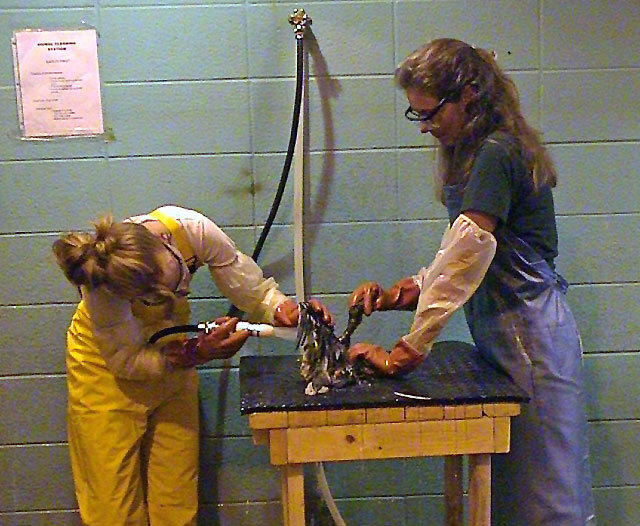
Release of perfectly cleaned birds into larger areas, with both dry and wet areas

After a longer period of recovery, banding and release back into the wild

Based on 20 years of direct experience, Mr. Chris Battaglia (Executive Director of Focus Wildlife International) states:
"The window of opportunity to have a successful wildlife response is very, very limited. The longer it takes to collect the affected birds, the less likely it is that these birds will ever be released. Obviously, poor facilities, resources and expertise will only drive down the release rate even further."
These comments and the facilities required need to be considered deeply in light of the recent oil-spill off the Taean peninsula.
Those responsible for this massive and damaging spill should be strongly encouraged to provide significant funding to assist in oiled wildlife recovery efforts. These funds should be given to help save oiled birds not only caused by this spill (as now already three weeks have passed, and there is probably little possibility of saving many of the birds that have been oiled), but also to assist in longer-term future wildlife recovery efforts too.
Birds Korea December 24th, 2007
December 19th-20th, 2007.
Preliminary Report
December 20th, 2007.
Nial Moores, Ju-Yong-Ki and Andreas Kim (Map).
Introduction
Following the leak of c. 10, 500 metric tonnes of crude oil from the Hebei Spirit on December 7th 2007, 8 km offshore from the Taean Peninsula (west coast of South Korea), several requests for information have been made to Birds Korea about the likely impacts of this spill on birds.
Based on media, eyewitness and official accounts, oil from the spill was initially concentrated on the coastline closest to the spill site – a coastline of relatively low importance to bird populations (i.e. at that season, with no species of special conservation concern, and no species found in internationally important concentrations). Subsequently, a combination of seasonal dry winter-monsoon winds (typically from the northwest), and apparently a seasonal offshore sea current helped the oil to drift south along the coast, creating a potential threat to internationally important concentrations of birds found in the twin Important Bird Areas (BirdLife International, 2004) of Yubu Island and the mainland Geum Estuary (ca 120km to the south from the spill-centre). Some “oil balls” were also reported on shores of the eastern part of the Taean peninsula, in the outer part of Cheonsu Bay, within several kilometers of impounded freshwater reservoirs and rice-fields also supporting very large concentrations of waterbirds.
Consideration of the potential threat to the waterbirds of especially the Geum Estuary and Yubu Island increased further when eyewitness reports (both from Mr. Ju Yong-Ki of Birds Korea, and from local fisherfolk) confirmed that on December 15th oil balls started to appear on islands (e.g. Yeon Island, and Kyea Island: the latter only c. 7 km from Yubu Island) and on the mainland, on the northern side of the Dodun Village and peninsula (count site 7: see Table 1), within a few kilometers of the Geum Estuary tidal-flats. Moreover, on December 17th and 18th, several species of bird which had been contaminated with oil were observed on islands and beaches of Taean Peninsula. This included an estimated 34-43 out of 50 in a flock of 600 Dunlin Calidris alpina and Sanderling Calidris alba at count site 14, (for more details, please scroll below) - the first shorebirds reported contaminated by this oil-spill. These were in addition to the 30 or so birds (largely Black-tailed Gull Larus crassirostris, but also Great Crested Grebe Podiceps cristatus, Black-necked Grebe Podiceps nigricollis, Little Grebe Tachybaptus ruficollis, Temminck’s Cormorant Phalacrocorax capillatus and Ancient Murrelets Synthliboramphus antiquus) already taken into care or reported dead by local vet Dr. Kim Shin-Hwan.
Rapid Assessment: Method
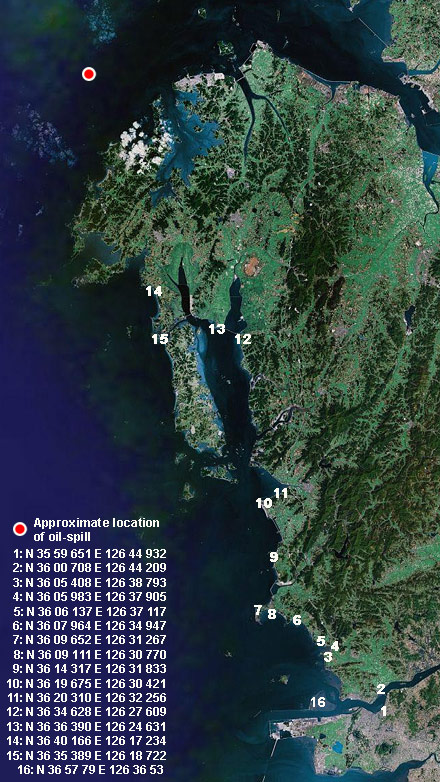
In response, a rapid assessment of oil (presence or absence) and waterbirds (abundance, and number of birds oiled) was conducted at 15 points on December 19th between the Geum Estuary (starting at: N 35 59 651, E 126 44 932) and the southwest of the Taean Peninsula (finishing at: N 36 35 389 E 126 18 722), between 08:30 and 17:30; and on Yubu Island on December 20th (10:00-13:00). Efforts were made to count or estimate the total numbers of waterbirds present at each site (identified to the species level), and active searching of oil on those individuals that could be seen sufficiently well was then conducted. When oil was identified on an individual bird, a score system of 0-5 was then used to describe the approximate extent of oil contamination, with e.g. 1 to indicate light staining or spotting on the underparts, and 5 to indicate almost complete saturation of the plumage. All counts were made through a tripod mounted telescope by Nial Moores (Birds Korea), with further searching for oil on birds and beaches also by Ju Yong-Ki (Birds Korea) and Han Sung Woo (Green Korea United), joined at count points 13-16 by Lee Namue (UNDP-GEF/Ministry of Environment Korea Wetlands Project). Presence or absence of oil at count sites was also assessed through walking along the tide-line at several locations, and in some other locations through interview of local residents encountered on site. All count locations were recorded with a Garmin GPS 60, and digital images were taken of all sites and of some of the oiled birds by Ju Yong-Ki.
Some further assessment was also made of wildlife recovery efforts, through visiting two holding centres (outside the Taean National Parks office, and in Seosan City) and through meetings with key personnel, including Dr. Choi Chong Kwan (Chief Manager of the Korea National Park Service), Dr. Jo Ki Man (Korea Animal Rescue and Management Association), and veterinarian Dr. Kim Shin-Hwan (Seosan-Taean KFEM, and member of Birds Korea). Some key elements of these visits and discussions will be included in a follow-up report.
Results
No oil was found at any of the count sites on either December 19th or 20th – even though oil had been recorded in the previous days/week at count sites 7, 14 and 15, and vats of oil (which had been collected earlier that same afternoon from inshore sea areas) were watched being unloaded from boats at count site 15.
In total, 333 birds contaminated with oil were identified during the two-day survey, comprised of 13 species, with the vast majority (289) made up of a single species, Black-tailed Gull Larus crassirostris.
Table 1: Count Locations, and numbers of species and individual waterbirds contaminated with oil (December 19th-20th, 2007).
| Count Site # | Co-ordinates | Approx. number of waterbirds present / checked | Number of species found contaminated with oil | Number of Individuals contaminated with oil | Notes on “Oil Score”/ Species |
| 1 | N 35 59 651 E 126 44 932 | 6500/300 | 3 | 5 | All 0.5-1 |
| 2 | N 36 00 708 E 126 44 209 | 2300/510 | 2 | 2 | Both 0.5-1 |
| 3 | N 36 05 408 E 126 38 793 | 150/46 | 0 | 0 | |
| 4 | N 36 05 983 E 126 37 905 | 44/44 | 0 | 0 | |
| 5 | N 36 06 137 E 126 37 117 | 10/10 | 0 | 0 | |
| 6 | N 36 07 964 E 126 34 947 | 700/80 | 1 | 1 | 0.5-1 |
| 7 | N 36 09 111 E 126 30 770 | 200/178 | 5 | 135 | 21 scored 4-5 |
| 8 | N 36 09 652 E 126 31 267 | 130/92 | 4 | 7 | 6 scored 1, 1 scored 4 |
| 9 | N 36 14 317 E 126 31 833 | 65/25 | 2 | 10 | Most scored 1 |
| 10 | N 36 19 675 E 126 30 421 | 25/16 | 1 | 1 | Scored 3 |
| 11 | N 36 20 310 E 126 32 256 | 390/166 | 4 | 57 | Most scored 2-3 |
| 12 | N 36 34 628 E 126 27 609 | 380/300 | 2 | 3 | Inc. 2 Larus saundersi |
| 13 | N 36 36 390 E 126 24 631 | 40/28 | 1 | 1 | |
| 14 | N 36 40 166 E 126 17 234 | 30/0 | 0 | 0 | |
| 15 | N 36 35 389 E 126 18 722 | 1000+/300 | 3 | 104 | |
| 16 | N 36 57 079 E 126 36 053 | 12500/600 | 4 | 7 |
Table 2: Numbers of Waterbirds contaminated with oil, by species at 16 count sites (December 19th-20th).
| Species Name | Number of individuals contaminated |
| Tadorna tadorna | 6 |
| Anas platyrhynchos | 1 |
| Bucephala clangula | 1 |
| Podiceps cristatus | 1 |
| Haematopus (ostralegus) osculans | 3 |
| Calidris alpina | 1 |
| Larus crassirostris | 289 |
| Larus canus | 12 |
| Larus vegae | 10 |
| Larus schistisagus | 3 |
| Larus heuglini | 1 |
| Larus ridibundus | 2 |
| Larus saundersi | 2 |
| Total | 333 |
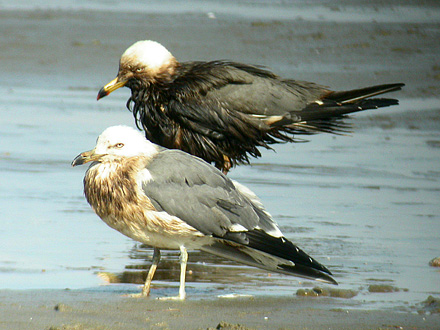
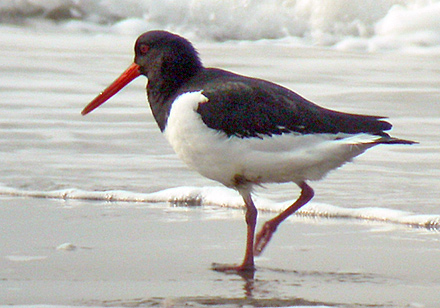
Conclusions
Considering the large area of open sea, the number of islands and the extent of coast and beach affected by oil; the species composition and the likely abundance of birds in the affected given area; and the lack of bird survey coverage, it would seem probable that several thousand birds have so far been contaminated with oil, with the vast majority of these comprised of species that often feed in marine and inshore area (such as Larus crassirostris), with a lesser number of species dependent on tidal-flats and beaches also affected. Many of the birds found contaminated with oil were still relatively active when seen by this survey (many were first located by their very active preening), and would likely be difficult to trap for cleaning – especially without a large, trained team to conduct such activities.
Further, we were of the opinion that while the oil clean-up effort has been very well-coordinated and extremely well-supported by volunteers, and while great efforts have been made to clean a few oil-contaminated birds, it is apparent that the existing infrastructure is completely inadequate to deal with the large numbers of birds presently affected.
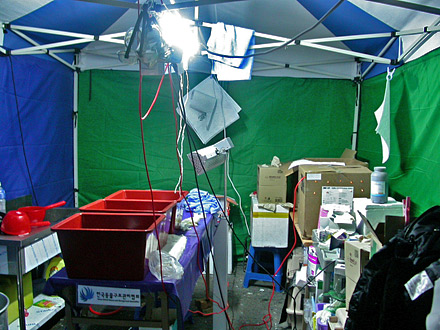
Reference
BirdLife International (2004). Important Birds Areas in Asia: key sites for conservation. Cambridge, UK: BirdLife International (BirdLife Conservation Series No.13).
Note: All information above is open for reproduction by others, provided that Birds Korea is identified as the source.
December 17th-18th Update
On December 17th, there was a flock of ca 600 shorebirds (mixed Sanderling Calidris alba and Dunlin C. alpina) at Anmyeon Do, toward the southern end of the Taean peninsula, in an area cleaned of oil by local people.
One image taken of this flock by Mr. Ju Yong-Ki shows 75 Dunlin , with probably c. 50 of these in some detail (although distant). Of these Dunlin (assuming that all are in either first winter or adult winter plumage, which is safe assumption by mid-December), it appears that between 34 and 43 show some evidence of contamination by oil, with 2 or 3 birds more heavily marked, and others less so (there is a large margin of error, due to the effects of shadow and range).
Mr. Ju Yong-Ki also took one further close-up shot of an oiled Dunlin at the same site.
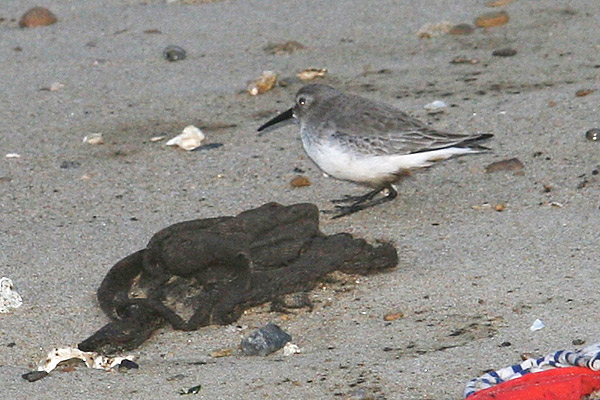
On December 18th, on Gai Island, off the Taean Peninsula, Mr. Ju Yong-Gi also saw what was believed to be a live Kentish Plover Charadrius alexandrinus completely covered with oil, and found one dead oiled shorebird.
Further field assessment of the impacts of the oil spill on birds, especially shorebirds, will be made by Birds Korea on December 19th and 20th, including at the Geum Estuary, after the degradation of Saemangeum due to reclamation, now South Korea's most important known shorebird site.
West Coast Oil Spill: Birds Korea News Update, December 17th
Oil has already coated (and been largely/partly cleaned up from) several kilometers of coast, with much of the thickest oil washed up on c 30 km of beaches (10 km northeast of the spill centre, round to Garolim Bay, and 20 km or more south along the west coast of the Taean peninsula). At sea, the broken slick as of December 17th now apparently extends up to c 130 km south from the spill centre, with oil washing up on beaches and tidal-flats as far south as the Geum Estuary.
From previous bird surveys, the Taean peninsula is one of the poorest areas for waterbirds on the Korean coast. However, areas south from there, including most notably the Geum Estuary, are extremely important for large numbers of waterbirds.
Birds Korea now believes that the presence of a significantly greater number of experienced specialists in wildlife recovery would be of very great assistance to ongoing domestic recovery efforts at this time.
This is because, based on information so far received:
In the Taean area closest to the spill, few wild birds have been found and/or recovered (tens only). However, existing capacity for wildlife recovery at Taean already seems more or less to have been reached, and there is some concern about how to improve holding and recovery facilities (there and elsewhere);
There are perhaps no other adequately staffed wildlife recovery centres established elsewhere along the coast - with very limited facilities for recovery in e.g. Gunsan City, next to the Geum Estuary (one known facility includes e.g. outdoor public cages);
There has been a massive (heroic) domestic volunteer and government response to the clean-up, but even now only a very small number of experts with significant experience of oil spill recovery have been assisting assessment of the oil spill impacts.
There appears to be a general sense among at least some bodies that the worst might be over, and that the situation is now more or less under control. Media and popular concern will also likely diminish rapidly in the coming days, due to a national election and upcoming holidays and end of year celebrations. However, based on information provided by those involved in clean-up operations, and on eyewitness reports of oil now washing up on beaches and islands of the Geum Estuary, Birds Korea believes that the threats from the oil spill have not decreased, as the oil has spread southwards. Rather the threats to wildlife have very likely increased greatly over the past few days - and there is now a growing possibility of a very major wildlife disaster.
Mr. Ju Yong-Ki, for example, first noted oil balls reaching beaches and tidal-flats in the Seocheon/Geum Estuary area on December 15th. In one small bay alone at Seocheon tidal-flats that day there were over 400 gulls (mostly Larus crassirostris) concentrated at the tide-line, and many of these were already stained with oil.
Wintering waterbirds now at potential risk from the oil spill in and offshore from e.g. the Geum Estuary-Seocheon coastline alone appear to include:
Eastern Oystercatcher Haematopus (ostralegus) osculans, with c 3, 000 or 30% of the total minimum estimated population wintering at the Geum Estuary;
Eurasian Curlew Numenius arquata (c. 2000 most years);
Dunlin Calidris alpina (c. 5000 maximum most years);
Common Shelduck Tadorna tadorna (c. 2, 000 most years, but 13,000 in 2001, according to Ministry of Environment data)
Gulls, c 5,000 most years (most Black-tailed Larus crassirostris, Black-headed L. ridibindus and Vega L. vegae, but also including 500+ Saunders's Gulls Larus saundersi),
Dabbling (thousands) and aythya ducks (hundreds), especially Greater Scaup Aythya marila and Pochard A. ferina;
In marine areas, small numbers of grebes (especially Podiceps cristatus), Ancient Murrelet Synthliboramphus antiquus and Temminck's Phalacrocorax capillatus and Pelagic Cormorants/Shags Leucocarbo pelagicus, as well as some loons Gavia spp (for which satellite tracking has proven a connection between Alaska and Korea/the Yellow Sea) also over-winter.
Beyond birds, the area is very important for Finless Porpoise, with at least one dead porpoise washed up at Taean on 16th.
Considering the large volume of oil being drifted south, and the massive concentrations of birds in the Geum/Seocheon area (as noted above), it seems quite possible that several thousands of birds will be affected, and many might be killed. According to experienced experts (e.g. within Focus Wildlife International, see http://www.focuswildlife.net/), even small quantities of oil contamination can be fatal for affected waterbirds. Oil prevents birds from maintaining the necessary high plumage condition critical for effective thermoregulation, and overnight temperatures on the west coast of Korea at e.g. Gunsan are forecast to fall below freezing this week (-1 C on 18th; -2C on 19th December), with wind chill a further element of concern.
We will continue to post information and images as we receive them.
Birds Korea, December 17th, 2007.
Links to additional information an news:
The Impact of Oil at Sea on Seabirds in Atlantic Canada
Oil Spill off South Korea, Earth Observatory (NASA), December 12 2007
South Korea counts cost of national park oil spill, Reuters, December 10 2007
South Korea spill creates 'oil balls,' threatening fish, The China Post, December 15 2007
A massive oil slick from a tanker collision on Friday, December 7th is now threatening a stretch of coast from the Taean Peninsula possibly as far south as the extremely important tidal-flats and sea areas of the Geum Estuary.
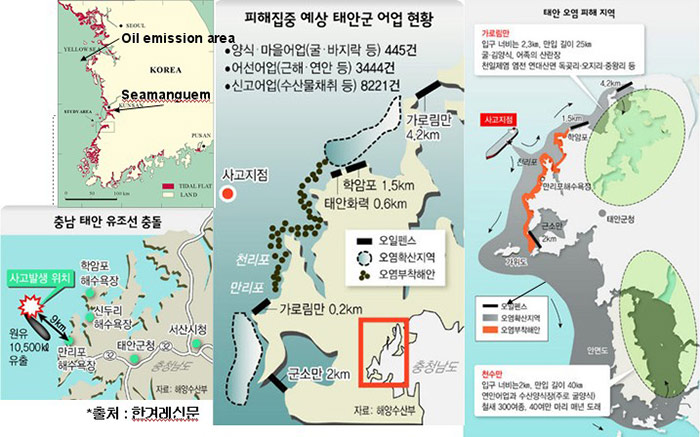
Background details of the accident can be found at:
http://news.yahoo.com/s/afp/20071210/wl_asia_afp/skoreashippingoilaccidentenvironment
Looking at the area generally and based on previous survey effort, the area of the Taean Peninsula presently being affected is not an especially important area for birds. However, due to its very great importance for fisheries and for scenic qualities, it is listed as one of the top 22 Priority Sites for Conservation in the Yellow Sea by the ongoing South Korean-Chinese Government/UNDP-GEF Yellow Sea Large Marine Ecosystem Program. Clearly, the spill will cause long-term and extensive ecological damage to the region, in addition to immediate hardship for large numbers of dependent fishing communities.
Further, based on an on-site assessment by Mr. Ju Yong-Gi (Birds Korea Formal Advisor for Saemangeum and the Geum Estuary) who visited the site on December 9th:
"Many" Red-breasted Merganser Mergus serrator and Temminck's Cormorant Phalacrocorax capillatus have already been found oiled;
The oil slick appears likely to be carried south by coastal currents towards tidal-flats between Gunsan and the Taean Peninsula, including possibly as far south as the Geum Estuary. These tidal-flats are extremely important internationally for a large range of bird species, and the Geum Estuary and Seosan/Cheonsu Bay wetlands have both been identified as Important Bird Areas by BirdLife International (as well as meeting multiple criteria for designation as Ramsar sites). Marine areas in this region also support decent populations of Finless Porpoise, as well as small numbers of wintering Ancient Murrelet Synthliboramphus antiquus and larger numbers of loons.
Both Mr. Ju Yong-Ki and Mr. Nial Moores will likely be visiting the area on 11th or 12th, and we will post further details on our websites as soon as we receive them.
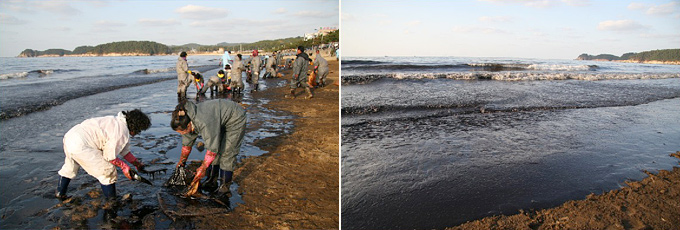
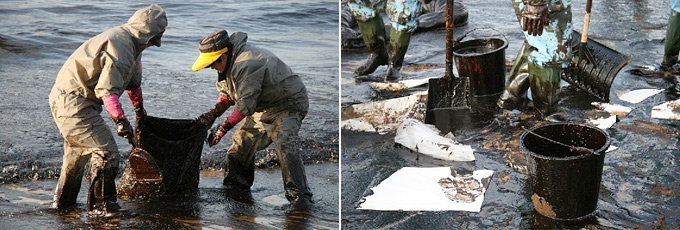
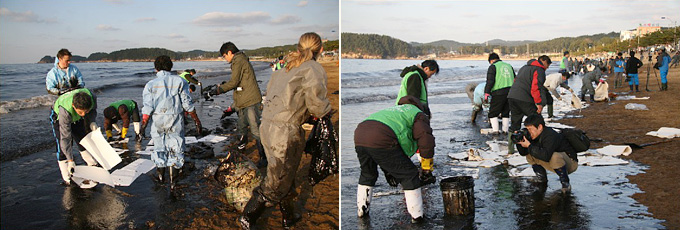
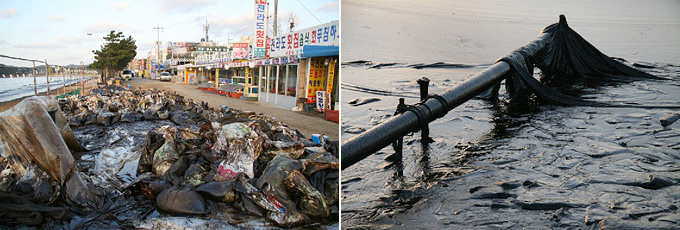
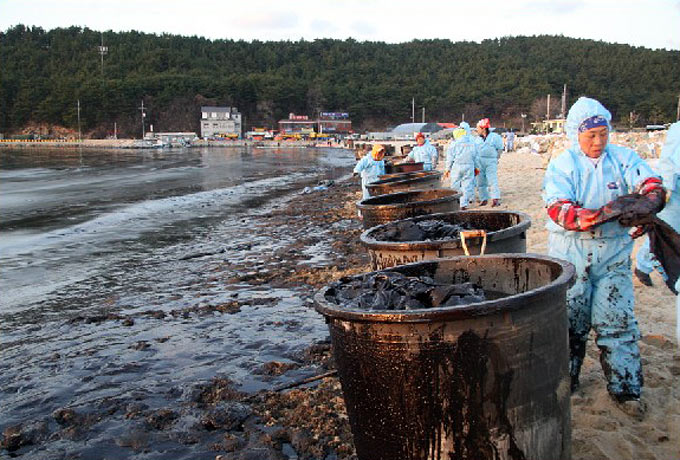
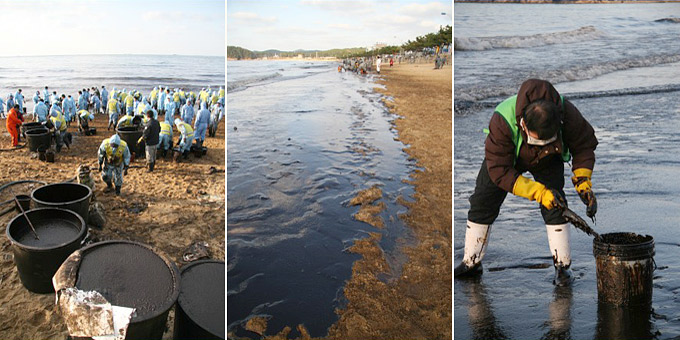
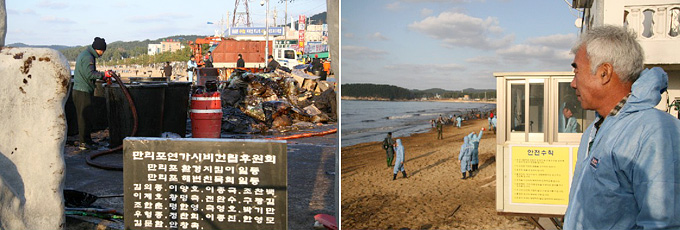
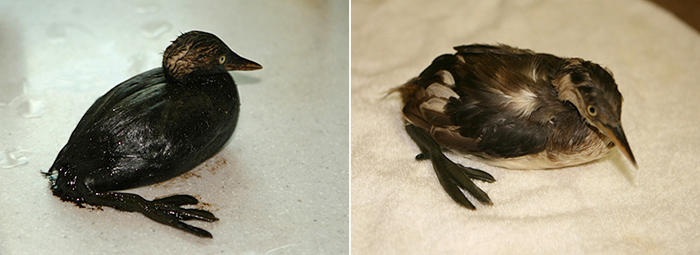
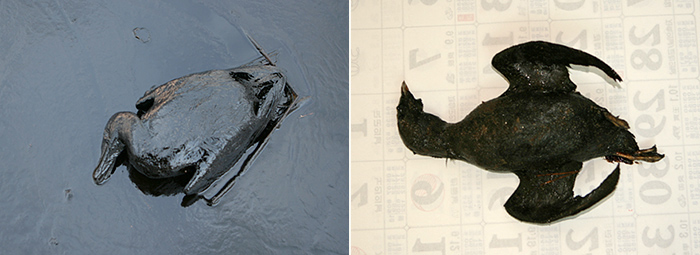
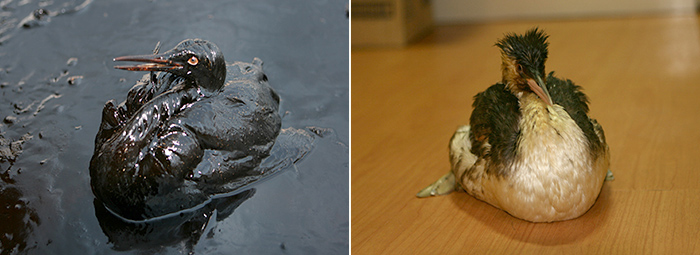
For further information relating to responses to oil spills, please refer to the following URLs, kindly provided by Dr.Nidhi Chauhan Nagabhatla, Post Doctoral Scientist- Landscape Ecology, International Water Management Institute (IWMI):
Birds Korea 1108 Ho, 3 Dong, Samick Tower Apt., 148-22, Namcheon-Dong, Su-Young-Gu
Busan, 618-762 Republic of Korea



